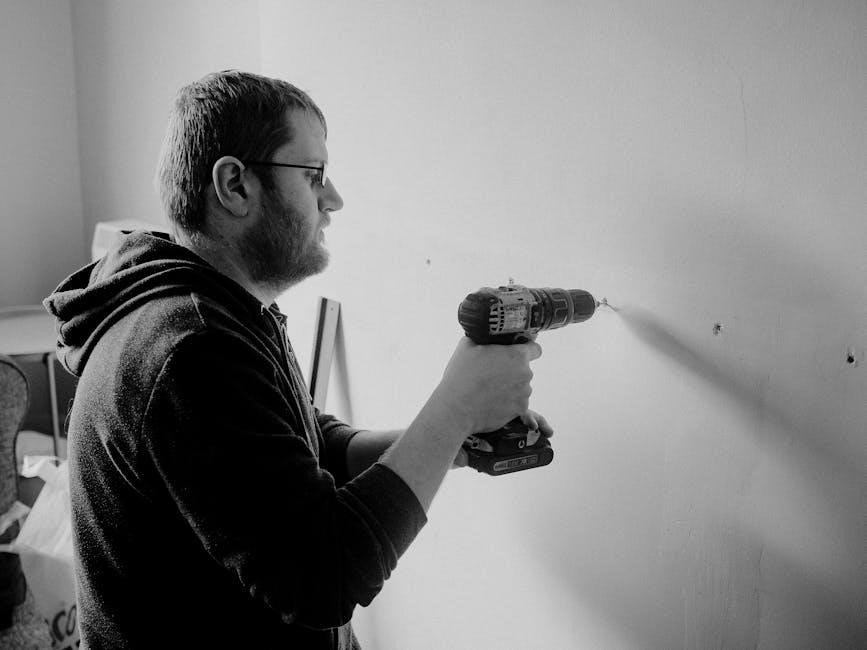
honeywell th5220d1003 installation manual
Welcome to the Honeywell TH5220D1003 installation guide. This manual provides a comprehensive overview of the FocusPro 5000 series non-programmable digital thermostat, ensuring proper setup and functionality for optimal performance. The manual is essential for proper installation, configuration, and operation of the Honeywell TH5220D1003 thermostat. It provides detailed instructions for wiring, system setup, and troubleshooting, ensuring safe and efficient use.
1.1 Overview of the Honeywell TH5220D1003
The Honeywell TH5220D1003 is a non-programmable digital thermostat designed for precise temperature control and ease of use. It belongs to the FocusPro 5000 series, offering reliability and compatibility with various HVAC systems. This thermostat is ideal for homeowners seeking a straightforward, energy-efficient solution for heating and cooling. Its digital interface allows for easy adjustments, and it supports multiple system types, including gas, oil, and electric systems. The TH5220D1003 is known for its accuracy, ensuring consistent comfort while reducing energy consumption. With its compact design and user-friendly features, it is a popular choice for residential installations. The thermostat also includes safety features and clear instructions for installation and operation.
1.2 Key Features of the Thermostat
The Honeywell TH5220D1003 thermostat offers a range of features designed for optimal performance and user convenience. It features a large, backlit digital display for easy readability, even in low-light conditions. The thermostat is compatible with a variety of HVAC systems, including single-stage heating and cooling, heat pumps, and dual-fuel systems. It provides precise temperature control with a consistency of ±1°F, ensuring consistent comfort. The device also includes a PR (Power Recovery) mode for heat pumps, which helps maintain temperature quickly after a power outage. Additional features include a built-in time guard, which protects the system from short cycling, and a compact design that fits seamlessly into any home decor. This thermostat is energy-efficient and designed for long-term reliability.
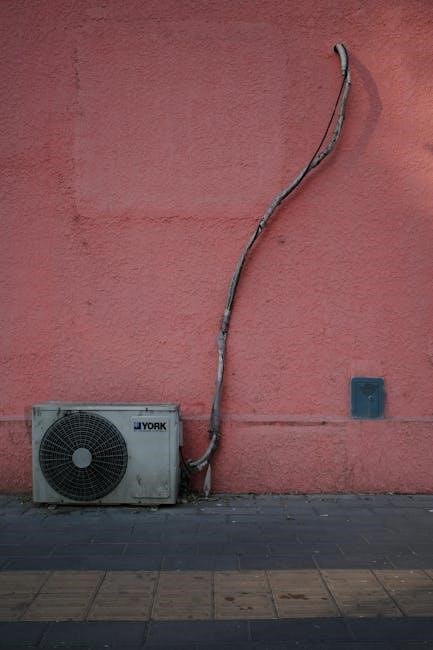
Pre-Installation Checklist
Ensure you have all necessary tools, materials, and safety gear. Verify system compatibility, turn off power, and prepare the area for installation. Refer to the manual.
2.1 Tools and Materials Needed
To install the Honeywell TH5220D1003, gather essential tools and materials. You’ll need a screwdriver (Phillips and flathead), pliers, wire strippers, and a voltage tester for safety. Ensure you have the wallplate, mounting screws, and wire nuts provided in the package. Additional materials like wall anchors may be necessary for uneven surfaces. A ladder or step stool could be helpful for higher installations. Keep the user manual handy for reference. Ensure all tools are within reach to streamline the process. Avoid using damaged or worn-out tools to prevent issues. Having a clean, dry workspace is also crucial for efficient installation. Finally, verify that all components are included in the packaging before starting.
2.2 Safety Precautions
Before installing the Honeywell TH5220D1003, ensure the power to your HVAC system is turned off at the circuit breaker or fuse box. Verify the power is off using a voltage tester to avoid electric shock. Never touch wires with bare hands, as this can cause injury. Always handle the thermostat by the edges to prevent damage from static electricity. Wear safety goggles and ensure the work area is well-lit and free from clutter. Avoid overreaching or standing on unstable surfaces. Use tools correctly to prevent damage or injury. Follow all instructions carefully, and if unsure, consult a licensed electrician. Safety should always be the top priority during installation.

Wallplate Installation
Begin by removing the old thermostat and preparing the wall area. Align the new wallplate with the mounting screws, ensuring it fits securely and is level.
3.1 Removing the Old Thermostat
Start by turning off the power to your HVAC system at the circuit breaker or fuse box to ensure safety. Remove the old thermostat by gently pulling it away from the wall. Disconnect the wires from the old thermostat and carefully label them for identification. If the wires are not labeled, take a photo or note their positions before disconnecting. Remove any screws or clips holding the old thermostat in place. Take out the wall anchors or screws securing the old wallplate. Once the old thermostat is completely detached, set it aside and prepare the area for the new wallplate installation. Ensure the wall is clean and dry before proceeding.
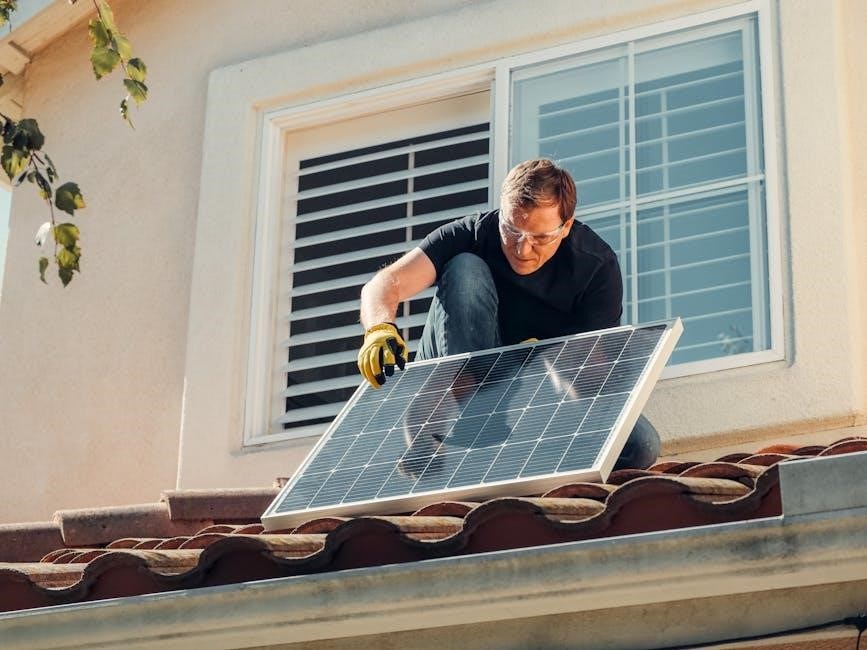
3.2 Mounting the New Wallplate
Locate the wall studs or use wall anchors to ensure a secure installation. Align the new wallplate with the mounting holes, ensuring it is level using the built-in leveling tool. Mark the screw positions on the wall and drill pilot holes if necessary. Insert wall anchors into the holes for added stability. Mount the wallplate by screwing it into place, ensuring it is tightly secured but not overtightened. Connect the wires to the appropriate terminals, following the wiring diagram provided in the manual. Double-check the connections and ensure the wallplate is flush against the wall for a professional finish. Refer to the wiring diagram for accurate terminal connections.
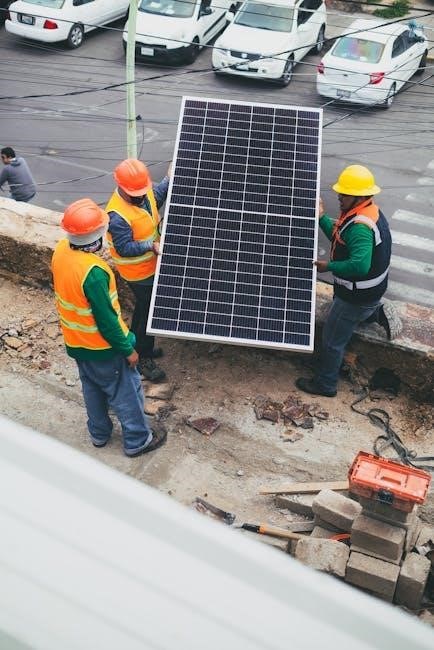
Wiring Instructions
Follow the wiring diagram to connect the appropriate wires to the correct terminals. Ensure all connections are secure and match the system requirements safely.
4.1 Understanding Terminal Designations
The Honeywell TH5220D1003 thermostat uses a standard terminal designations system to ensure proper wiring. Each terminal corresponds to a specific function, such as heating, cooling, or fan operation. Common terminals include R (24V power), W (heating stage), Y (cooling stage), G (fan), and C (common). Understanding these designations is critical to avoid wiring errors and ensure safe installation. Refer to the wiring diagram provided in the manual for exact terminal locations and their corresponding functions. Always match the wires from your HVAC system to the correct terminals to prevent malfunctions. If unsure, consult a licensed electrician or HVAC professional to verify the connections. Proper terminal connections are essential for the thermostat to operate efficiently and safely.
4.2 Connecting the Wires
Properly connecting the wires is crucial for the Honeywell TH5220D1003 thermostat to function correctly. Begin by matching the wires from your HVAC system to the correct terminals on the thermostat, referring to the wiring diagram for accurate connections. Strip the wire ends to ensure secure connections and avoid loose wires that could cause malfunctions. Gently insert each wire into the corresponding terminal and tighten the screw firmly but avoid over-tightening, which could damage the terminal or wire. Double-check all connections before restoring power to the system. If you encounter any issues or are unsure about the wiring, consult a licensed electrician or HVAC technician. Proper wire connections ensure safe and efficient operation of your heating and cooling system.
4.3 Wiring Diagrams
The wiring diagrams provided in the Honeywell TH5220D1003 installation manual are essential for ensuring correct connections. These diagrams illustrate the proper wire configurations for various HVAC systems, including 2-wire, 4-wire, and heat pump setups. Locate the diagram that matches your system type and carefully follow the terminal designations. Use the color codes and labels on the wires to align them with the corresponding terminals on the thermostat. Double-check the connections against the diagram to avoid mismatches. If you’re unsure about the wiring configuration, consult the manual or Honeywell’s online resources for clarification. Properly following the wiring diagram ensures safe and efficient installation of the thermostat.

Power Options and Mounting
This section discusses the thermostat’s power requirements and mounting options. It covers battery installation, hardwiring, and proper wall placement for optimal performance and accessibility.
5.1 Power Requirements
The Honeywell TH5220D1003 thermostat requires a 24V AC power supply, typically derived from the HVAC system. It can be powered via a common wire (C-wire) or through battery operation. For battery power, two AA alkaline batteries are needed, providing up to 2 years of runtime. Hardwiring is recommended for continuous operation without battery replacements. Ensure the power source matches the thermostat’s voltage requirements to avoid damage. Always turn off power at the circuit breaker before installation to ensure safety. If unsure about wiring, consult a licensed electrician to prevent system damage or electrical hazards. Proper power setup ensures reliable performance and optimal functionality of the thermostat.
5.2 Mounting the Thermostat
Mounting the Honeywell TH5220D1003 thermostat requires careful alignment to ensure proper functionality. Begin by ensuring the wallplate is securely fastened to the wall using the provided screws or anchors. If necessary, use a level to ensure the wallplate is straight. Once the wallplate is installed, gently snap the thermostat onto the wallplate until it clicks into place. Make sure the thermostat is firmly seated to avoid any loose connections. If the wall surface is uneven, slight shimming may be needed for proper alignment. For drywall or plaster walls, use the included wall anchors to prevent screws from loosening over time. Proper mounting ensures the thermostat operates efficiently and maintains a professional appearance.
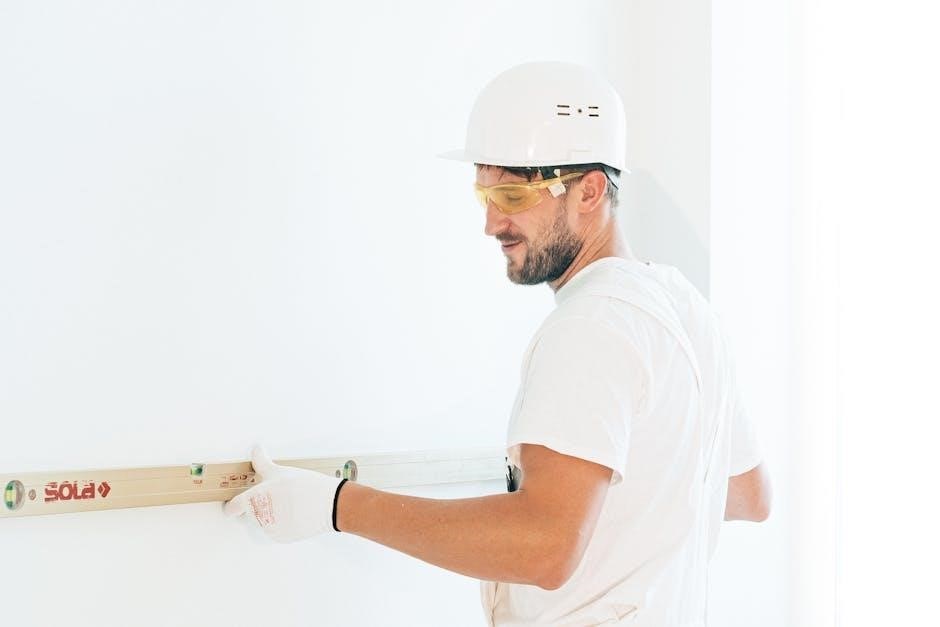
Installer Setup
Power on the thermostat and navigate through the menu to configure basic settings, ensuring proper system operation before handing over to the user.
6.1 System Configuration
During the system configuration, select the appropriate heating and cooling system type (e.g., gas, electric, or heat pump) to ensure compatibility. Set the fan operation to either “auto” or “on” based on the system requirements. Configure the temperature range and differential settings according to the user’s preferences or the system’s specifications. Use the thermostat’s menu navigation to access these settings, ensuring proper operation. Verify that the configuration matches the installed HVAC equipment to avoid malfunctions. For multi-stage systems, enable the correct number of heating and cooling stages. Refer to the wiring diagram if adjustments are needed for compatibility. Accurate system configuration is critical for optimal performance and energy efficiency.
6.2 Advanced Settings
In the advanced settings menu, configure options like humidity control, geofencing, and smart recovery to optimize performance. Adjust the temperature swing range to balance comfort and energy savings. Enable or disable features such as adaptive recovery, which learns the system’s operation to pre-heat or cool the space. Set the fan circulation mode to run continuously or intermittently for better air distribution. Access the installer settings to adjust parameters like maximum and minimum temperature limits. Use the keypad lockout feature to prevent unauthorized changes. Ensure compatibility with external devices like dehumidifiers or ventilators by enabling the proper control modes. Refer to the menu prompts for detailed guidance on each setting. Properly configuring these advanced features ensures the thermostat operates efficiently and meets specific user needs.
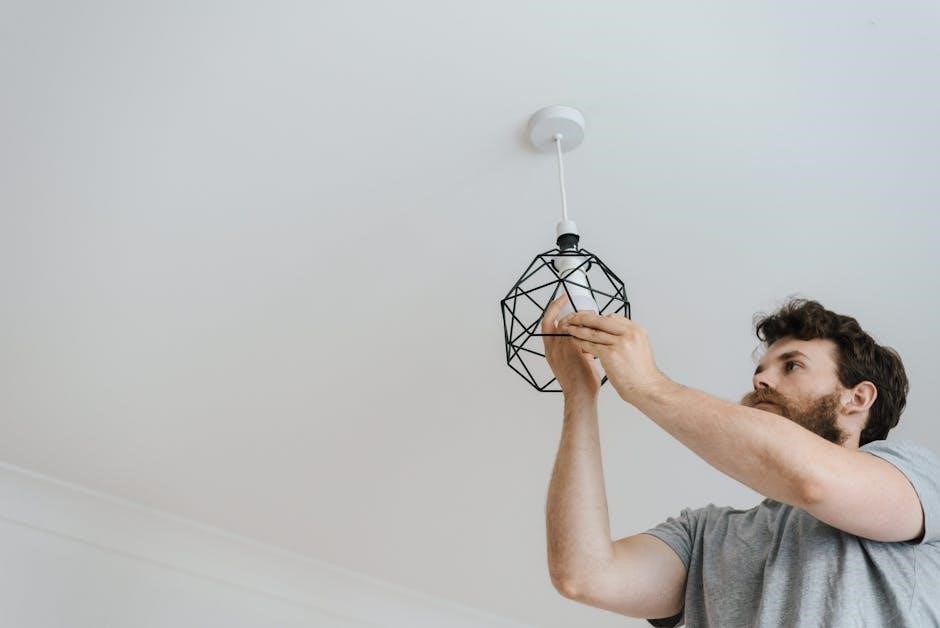
System Configuration
Configure heating, cooling, and ventilation systems to optimize performance. Set up heat pumps, dual fuel, or standard HVAC systems. Customize features for enhanced efficiency and comfort.
7.1 Heating and Cooling Settings
Configure the Honeywell TH5220D1003 thermostat to suit your HVAC system. Set the heating and cooling modes, such as Heat Pump, Dual Fuel, or Conventional. Adjust temperature ranges, differential, and cycle rates for optimal performance. Enable features like Emergency Heat for heat pumps or Auxiliary Heat for additional warmth. Program schedules to automate temperature changes based on your daily routines. Ensure proper configuration of Cooling Recovery and Smart Response for energy efficiency. Verify that all settings align with your system type and regional climate for reliable operation. Proper configuration ensures balanced heating and cooling, improving comfort and energy savings.
7.2 Customizing Features
Customize the Honeywell TH5220D1003 thermostat to match your preferences and lifestyle. Program schedules to adjust temperatures automatically based on your daily routine. Set temperature limits to prevent extreme heating or cooling. Enable the Smart Response feature to optimize system performance; Adjust the fan settings, such as Auto or Continuous On, for consistent airflow. Utilize the Keypad Lockout feature to prevent unauthorized changes. Configure the Remote Sensor option if using an external temperature sensor. Customize alerts for system notifications and maintenance reminders. Adjust the display settings, such as brightness and units of measurement. These customizations enhance comfort, efficiency, and ease of use, ensuring the thermostat operates according to your specific needs and preferences.
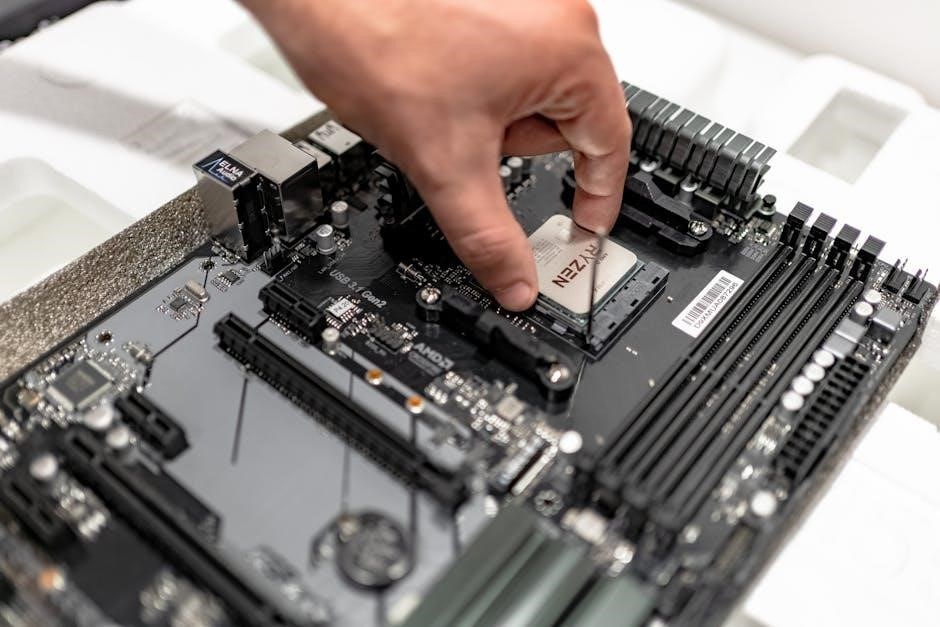
Troubleshooting Common Issues
Address common issues like blank displays, unresponsive controls, or system errors. Check power sources, wiring connections, and system settings. Ensure proper installation and configuration. Refer to the manual for specific error codes and solutions. Reset the thermostat if necessary. Verify temperature settings and sensor accuracy. Consult Honeywell support for persistent problems.
8.1 Common Wiring Issues
Common wiring issues with the Honeywell TH5220D1003 include loose connections, incorrect terminal assignments, or reversed polarity. Ensure all wires are securely attached to the correct terminals as per the wiring diagram. Verify that the system’s power is off before making any adjustments. Check for short circuits or damaged wires, which can prevent proper functionality. If the thermostat fails to power on, confirm that the circuit breaker or fuse is not tripped. For heat pumps, ensure the reversing valve wiring is correctly connected. Refer to the terminal designations in the manual to match wires accurately. If issues persist, reset the thermostat or consult a licensed electrician.
8.2 System Malfunction Solutions
If the Honeywell TH5220D1003 thermostat malfunctions, start by resetting the system. Turn off power at the circuit breaker, wait 30 seconds, and restore power. Check for error codes on the display, such as “E1” or “E2,” and consult the manual for specific solutions. Ensure the thermostat is properly configured for your heating/cooling system type. If the display is blank, verify wiring connections and ensure the battery (if applicable) is installed correctly. For no heat or cool issues, check system settings and ensure the temperature is set correctly. If problems persist, perform a factory reset by holding the “Menu” and “Minus” buttons simultaneously for 10 seconds. Contact Honeywell support if issues remain unresolved.
The Honeywell TH5220D1003 thermostat is now successfully installed and configured. Ensure all settings are tested, and refer to the manual for future adjustments or maintenance.
9.1 Final Check and Testing
Once the Honeywell TH5220D1003 thermostat is installed, perform a final check to ensure proper functionality. Verify that all wires are securely connected and the wallplate is properly mounted. Turn on the power and check the display for clarity and responsiveness. Test the thermostat by running a full heating and cooling cycle to confirm correct operation. Ensure there are no error messages or unusual behavior. Review all settings, including schedules and temperature limits, to match your preferences. Finally, ensure the system transitions smoothly between heating and cooling modes. If everything functions correctly, the installation is complete and ready for daily use.
9.2 Maintenance Tips
To ensure long-term performance of the Honeywell TH5220D1003 thermostat, regular maintenance is essential. Replace the batteries annually or as indicated by the low-battery warning. Clean the display and exterior with a soft, dry cloth to prevent dust buildup. Avoid using harsh chemicals or abrasive materials that may damage the screen. Check and update the system software periodically to access new features and improvements. Inspect the wiring connections to ensure they remain secure and free from corrosion. Additionally, verify that the thermostat is level and properly aligned on the wall for accurate temperature sensing. Finally, schedule annual HVAC system maintenance to ensure optimal performance and compatibility with the thermostat.
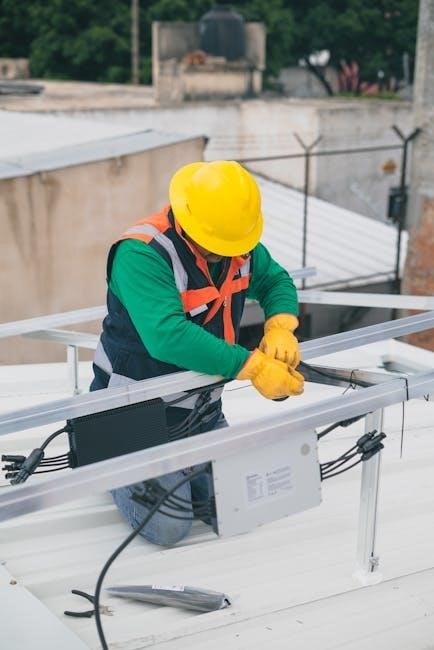
Additional Resources
Visit the Honeywell website for comprehensive guides, FAQs, and community forums. Explore video tutorials and troubleshooting articles for additional support. Contact Honeywell support for further assistance.
10.1 Downloading the Full Manual
To obtain the Honeywell TH5220D1003 installation manual, visit the official Honeywell website. Navigate to the “Support” or “Products” section and search for the model number. Look for a download link, preferably in PDF format and in English. If unavailable, consider third-party sites like ManualsLib or contact Honeywell support directly for assistance. Additionally, check the product packaging for a physical copy. Ensure you download the latest version for accurate information. Having the manual is crucial for proper installation and troubleshooting, making the effort to find it worthwhile.
10.2 Contacting Honeywell Support
For assistance with the Honeywell TH5220D1003 installation or operation, contact Honeywell Support directly. Visit the official Honeywell website and navigate to the “Contact Us” section; You can reach them via phone, email, or live chat. Provide your model number and a detailed description of your issue for faster resolution. Honeywell’s customer service is available during business hours, Monday through Friday. Additionally, the website offers a comprehensive FAQ section and troubleshooting guides. If you need immediate help, calling their toll-free number is recommended. Ensure you have your thermostat’s serial number ready for efficient support. Honeywell’s team is trained to address installation, wiring, and operational queries effectively.